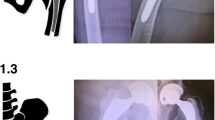Abstract
We studied 14 periprosthetic femoral fractures out of a series of 619 hydroxyapatite coated hip implants and compared the outcome to published treatment algorithms using the Vancouver classification. There were five type A fractures, six B1, two B2, and one type B3 fracture. All but one type A fractures were treated conservatively. Compared with the Vancouver classification, we observed a different fracture type in the type B fractures. No fractures at the tip of the stem were seen, as in cemented implants. Three B1 fractures were treated operatively due to fracture displacement, and three were treated conservatively. The B2 and B3 fractures were managed with long, uncemented, revision stems because of a disrupted bone–prosthesis interface. All fractures healed well. This study confirms that the modified algorithm of management of periprosthetic fractures, using the Vancouver classification, is a simple, reproducible, classification system for uncemented prostheses. Conservative treatment is a valid option if the implant is stable whilst surgical intervention is mandatory if the implant is loose.
Résumé
Nous avons étudié 14 fractures fémorales péri prothétiques dans une série de 619 implants de la hanche recouverts d’hydroxyapatite et nous avons comparé le résultat à l’algorithme de traitement utilisant la classification de Vancouver. Il y avait cinq fractures de type A, six de type B1, deux de type B2 et une de type B3. Toutes les fractures de type A, sauf une, ont été traités d’une manière conservatrice. Comparé à la classification de Vancouver nous avons observé un type de fracture différent dans le type B. Aucune fracture à l’extrémité de la tige n’a été vue comme dans les implants cimentés. Trois fractures B1 ont été opérées à cause du déplacement et trois a été traité d’une manière conservatrice. Les fractures B2 et B3 ont été traités avec des tiges longues de révision, sans ciment, à cause d’une interface os-prothèse interrompu. Toutes les fractures ont consolidé. Cette étude confirme que l’algorithme modifié de gestion des fractures péri prothétiques, en utilisant la classification de Vancouver, est un système de classification simple, reproductible, pour les modalités du traitement avec des implants sans ciment. Le traitement conservateur est une option valable en cas d’implant stable, cependant qu’en cas d’implant descellé l’intervention chirurgicale est obligatoire.



Similar content being viewed by others
References
Beals RK, Tower SS (1996) Periprosthetic fractures of the femur. An analysis of 93 fractures. Clin Orthop 327:238–246
Berry DJ (1999) Epidemiology: hip and knee. Orthop Clin North Am 30:183–190
Brady OH, Garbuz DS, Masri BA, Duncan CP (1999) The treatment of periprosthetic fractures of the femur using cortical onlay allograft struts. Orthop Clin North Am 30:249–257
Cooke PH, Newman JH (1982) Fractures of the femur in relation to cemented hip prostheses. J Bone Joint Surg Br 70:368–369
Duncan CP, Masri BA (1995) Fractures of the femur after hip replacement. Instr Course Lect 44:293–304
Duwelius PJ, Schmidt AH, Kyle RF, Talbott V, Ellis TJ, Butler JB (2004) A prospective, modernized treatment protocol for periprosthetic femur fractures. Orthop Clin North Am 35:485–492
Gill TJ, Sledge JB, Orler R, Ganz R (1999) Lateral insufficiency fractures of the femur caused by osteopenia and varus angulation: a complication of total hip arthroplasty. J Arthroplasty 14:982–987
Heekin RD, Engh CA, Herzwurm PJ (1996) Fractures through cystic lesions of the greater trochanter. A cause of late pain after cementless total hip arthroplasty. J Arthroplasty 11:757–760
Johansson JE, McBroom R, Barrington TW, Hunter GA (1981) Fractures of the ipsilateral femur in patients with total hip replacement. J Bone Joint Surg Am 63:1435–1442
Learmonth ID (2004) The management of periprosthetic fractures around the femoral stem J Bone Joint Surg Br 86:13–19
Lotke PA, Wong RY, Ecker ML (1986) Stress fracture as a cause of chronic pain following revision total hip arthroplasty. Report of two cases. Clin Orthop 206:147–150
Masri BA, Meek RM, Duncan CP (2004) Periprosthetic fractures evaluation and treatment. Clin Orthop 420:80–95
Mont MA, Maar DC (1994) Fractures of the ipsilateral femur after hip arthroplasty. A statistical analysis of outcome based on 487 patients. J Arthroplasty 9:511–519
Oosterbos CJ, Rahmy AI, Tonino AJ, Witpeerd W (2004) High survival rate of hydroxyapatite-coated hip prostheses: 100 consecutive hips followed for 10 years. Acta Orthop Scand 75:127–133
Rahmy AI, Gosens T, Blake GM, Tonino A, Fogelman I (2004) Periprosthetic bone remodelling of two types of uncemented femoral implant with proximal hydroxyapatite coating: a 3-year follow-up study addressing the influence of prosthesis design and preoperative bone density on periprosthetic bone loss. Osteoporos Int 15:281–289
Tadross TS, Nanu AM, Buchanan MJ, Checketts RG (2000) Dall–Miles plating for periprosthetic B1 fractures of the femur. J Arthroplasty 15:47–51
Tonino AJ, Rahmy AI (2000) The hydroxyapatite-ABG hip system: 5- to 7-year results from an international multicentre study. The International ABG Study Group. J Arthroplasty 15:274–282
Tonino AJ, Therin M, Doyle C (1999) Hydroxyapatite-coated femoral stems. Histology and histomorphometry around five components retrieved at post mortem, J Bone Joint Surg Br 81:148–154
Tower SS, Beals RK (1999) Fractures of the femur after hip replacement: the Oregon experience. Orthop Clin North Am 30:235–247
van Rietbergen B, Huiskes R (2001) Load transfer and stress shielding of the hydroxyapatite-ABG hip: a study of stem length and proximal fixation. J Arthroplasty 16:55–63
Wu CC, Au MK, Wu SS, Lin LC (1999) Risk factors for postoperative femoral fracture in cementless hip arthroplasty. J Formos Med Assoc 98:190–194
Author information
Authors and Affiliations
Corresponding author
Rights and permissions
About this article
Cite this article
van der Wal, B.C.H., Vischjager, M., Grimm, B. et al. Periprosthetic fractures around cementless hydroxyapatite-coated femoral stems. International Orthopaedics (SICOT) 29, 235–240 (2005). https://doi.org/10.1007/s00264-005-0657-3
Received:
Accepted:
Published:
Issue Date:
DOI: https://doi.org/10.1007/s00264-005-0657-3




